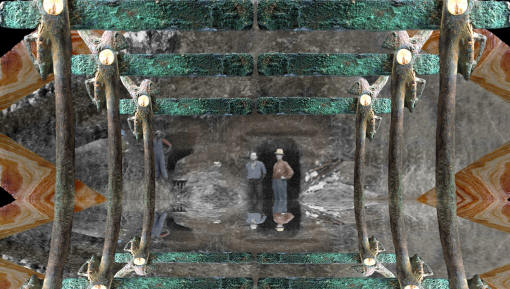|
"This mound (Craig
Mound) undoubtedly contained one of
the richest deposits of archaeological materials that has been
discovered in the united States."---1980, Joan
S. Gardner, "The Conservation Of Fragile Specimens From The Spiro Mound,
LeFlore County, Oklahoma," p. 1.
"There were three kinds of mounds at Spiro. One type was raised as a
platform for a structure; the second was an earth cover for a destroyed
building; and the third is what is called an accretional burial mound,
one built up of increasing layers of burials, burial goods and earth.."---1981,
Barbara Page, "Spiro Mound Artifacts Reveal 12th Century Culture,"
The Gilcrease Magazine Of American History And Art, p. 7- 8.
"The most distinctive feature of the site (Spiro
Mound) was the saddle-shaped mound
known as The Spiro Mound or the Great Temple Mound, (It has been renamed
the Craig Mound---)."---2004, Larry G. Merriam
& Christopher J. Merriam, "The Spiro Mound: A Photo Essay," p. 5.
"Spiro Mound was part of the greater Spiro Mound site located in
eastern Oklahoma on the south bank of the Arkansas River."---2004,
Larry G. Merriam & Christopher J. Merriam, "The Spiro Mound: A Photo
Essay," p. 5.
"The Spiro artifact record is primarily a corpus of grave goods, but
despite its specialized nature it is one that sheds great light on
Mississippian cultural systems throughout the southeast."---1976,
James A. Brown, "Spiro Studies, Volume 4," p. IV.
"The privileged were honored at death
with special treatment, and the mounds result from the highly complex
ritual associated with the burials of the dead elite."---1981,
Barbara Page, "Spiro Mound Artifacts Reveal 12th Century Culture,"
The Gilcrease Magazine Of American History And Art, p. 7.

CRAIG MOUND & ARTIFACTS
SPIRO MOUND SITE
LE FLORE CO., OKLAHOMA
MISSISSIPPIAN PERIOD, CADDOAN CULTURE
Some of the photographs in this article were taken by professor Robert Bell in
1935 and 1937. Robert Bell was born in 1914 in Marion, Ohio and is now deceased.
He became interested in archaeology at an early age and began attending
Ohio State University in 1936. He also attended the University of New
Mexico and later the University of Chicago where he received his PhD.
He accepted a teaching position at the University of Oklahoma and
was curator of Archaeology at the Stovall Museum of Science and history
at the University of Oklahoma.
|
|
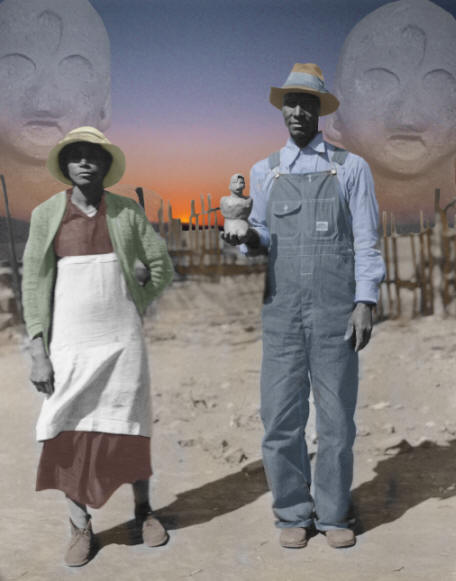
CLICK ON PICTURE FOR LARGE IMAGE OF BOTTLE
PHOTO FROM ROBERT BELL'S PHOTO ALBUM----LITHIC CASTING LAB
COLLECTION OF IMAGES.
COLORIZED AND ALTERED BY PETE BOSTROM
MR. COLUMBUS EUBANKS & WIFE
ODA
HOLDING HUMAN EFFIGY BOTTLE
SPIRO MOUND SITE
LE FLORE CO., OKLAHOMA
MISSISSIPPIAN PERIOD, CADDOAN CULTURE
(PICTURE CAPTION CORRECTED AS PER LARRY MERRIAM 8/31/10.
NEW INFORMATION HAS MADE A POSITIVE IDENTIFICATION OF THE PEOPLE IN
THIS PICTURE
AS MR. COLUMBUS EUBANKS AND WIFE ODA, NOT MR. R. W. WALL AS
PREVIOUSLY REPORTED IN THE BOOK)
This picture shows Mr. Columbus Eubanks standing next to his wife
Oda. Mr. Eubanks was hired by the Pocola Mining Company to dig at
Craig mound. He may have been paid with artifacts. He is holding a
human effigy water bottle that was dug from Craig mound and sold to
Harry Bell. This photograph was taken on April 9, 1936 and it was
taken from Robert's Bell's original photo album. This black & white
photograph has been colorized and altered with a different sky
background.
The human effigy bottle that Mr. Eubanks is holding was
purchased by Robert Bell's father, Harry T. Bell, on the same day
the picture was taken. The bottle is described as a kneeling female
figure with incised hands in the area of the stomach. The ears are
pierced and there is a topknot on top of the head. The facial
features are rather unique. The eyes and mouth were formed with a
stamp. Another oval design was also stamped onto the center of the
forehead. Bottles like this may have been used to hold
either water or seeds. |
|
|
Robert Bell
became interested in the excavation of Craig Mound from the very
beginning. He visited the site in the Spring of 1933 and again when the Pocola
Mining Company began digging the mound late in the same year. He also visited the site
in 1934 but didn't start taking photographs until he visited again in
1935 for an extended stay. He visited the site again in 1937 and
photographed the project when WPA workers were excavating the remaining mound structure. |
|
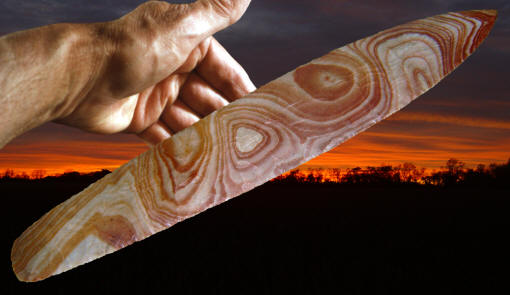
COLORFUL BIFACE
CRAIG MOUND
SPIRO MOUND SITE
LE FLORE CO., OKLAHOMA
This is
one of the most remarkable bifaces or flint blades ever found in the
United States. Its color and banding pattern is really quite
extraordinary. Bill or Hayden Vandagriff discovered it sometime in
April 1935. He found it while digging in one of the smaller mounds
or cones
located within the large saddle-shaped mound complex known as Craig
Mound. Robert Bell bought it in 1935 for his dad for $15.00. It
measures 13 1/8 inches long and 3/8 inch thick. Robert Bell
identified the material as Kay County chert from northern Oklahoma
but some believe it may be Kaolin chert from southern Illinois.
This colorful biface was on exhibit in the "Hero, Hawk, and
Open Hand: American Indian Art of the Ancient Midwest and South,"
exhibition. It was displayed at The Art Institute of Chicago and the
St. Louis Art Museum. |
|
|
For drama in archaeology no one needs to look any further than the
Pocola Mining Company's excavation of the great mortuary. The incident
touches many emotions. The human drama involved everything
from the protection of the spirits of the dead to the protection of
scientific data and add to that a measure of profit and treasure. The event began with a small group
of men who formed a business called the Pocola Mining Company who leased
the largest mound structure on the Spiro Mounds site. Their crude
project produced spectacular finds never seen before. The large numbers
of artifacts probably even surprised the diggers. No one had ever found
such a large volume of relics before. A collectors pamphlet printed in
1936 reports that, "The first digging began on the level terrace near
the small end, and within 10 minutes, four ear spools and four copper
needles were found." |
|
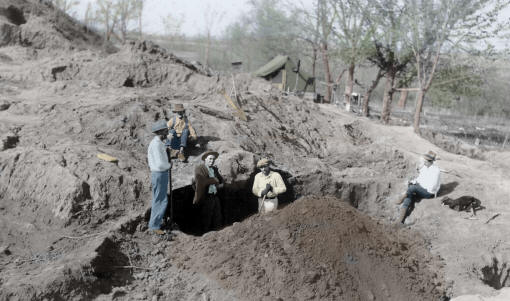
CLICK ON PICTURE FOR LARGER IMAGE
PHOTO FROM ROBERT BELL'S PHOTO ALBUM----LITHIC CASTING LAB
COLLECTION OF IMAGES.
COLORIZED BY PETE BOSTROM
THE POCOLA MINING COMPANY
SPIRO MOUND SITE
LE FLORE CO., OKLAHOMA
MISSISSIPPIAN PERIOD, CADDOAN CULTURE
This colorized image of a black and
white photograph from Robert Bell's photo album was taken sometime
in April 1935. It shows the excavation in progress by the Pocola
Mining Company. The caretaker, known as Dan, is sitting in the back.
The man standing to the left is Billy Vandergriff. The man standing to
his right in the hole is W. Guinn Cooper and the man next to him is
Hayden Vandergriff, who is Billy Vandergriff's brother. The man sitting to the
right in the picture is Robert Bell's school friend Chuck Aronhalt.
The caretakers tent, where he lived while protecting the site and
where the artifacts were held before being sold, can be seen in the
background. The location of the excavation is described as "the
third cone from the north." The largest mound in the structure
known as Craig Mound and
where the great mortuary tomb was discovered, can be seen in the
background to the left. The area where these men are digging is
believed to be the general area where the colorful biface
illustrated above may have been discovered. |
|
|
There was an immediate reaction from the scientific
community. Forrest E. Clements of the University of Oklahoma
Anthropology Department began a campaign to stop the destruction of the
mound in 1934. The Pocola Mining Company mined the site
for all it was worth until they were finally stopped by one of the first
antiquities laws in the country that prohibited digging an
archaeological site without a license. A 1936 collectors guide wrote that "When it was leaned that the boys of meager
circumstances had really found something worthwhile, steps were
immediately taken to enact a law forbidding them to excavate without a
license." |
|
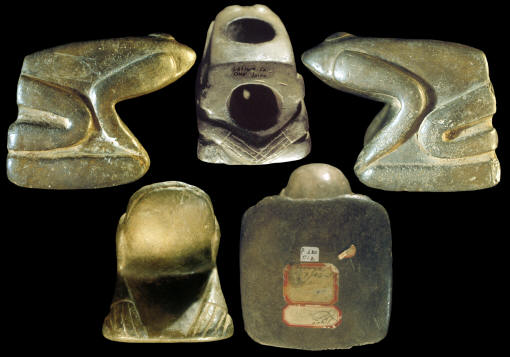
CLICK ON PICTURE FOR LARGER IMAGE
PRIVATE COLLECTION
FROG EFFIGY PIPE
SPIRO MOUND SITE
LE FLORE CO., OKLAHOMA
MISSISSIPPIAN PERIOD, CADDOAN CULTURE
This effigy frog pipe is
reported to have been discovered during the excavation of Craig
Mound. It was originally published in the June 7, 1936 issue of the
Daily Oklahoman. At least five frog pipes are reported to have been
found on the Spiro Mound site. Brown describes them as a relatively
common Mississippian pipe form. This is one of the nicest examples
ever found. The style of this pipe indicates
that it may have been made in the Cahokia Mounds area. The frog is
sitting on a platform which is a common feature on other Cahokia
style pipes. This pipe is made of flint clay. |
|
|
With each passing year, archaeological excavation and the artifacts
recovered become more and more
controversial. Native American Indian groups are concerned about the
spiritual nature of artifacts and human remains. Archaeologists are
concerned about protecting scientific data. Art professors and art
museums are concerned about protecting and displaying artifacts as art.
Collectors are concerned about continuing to own artifacts. As each
group voices their concerns they can literally bring tears of
emotion from individuals from another group. |
|

CLICK ON PICTURE FOR LARGER IMAGE
PHOTO FROM ROBERT BELL'S PHOTO ALBUM----LITHIC CASTING LAB
COLLECTION OF IMAGES.
COLORIZED BY PETE BOSTROM
CRAIG MOUND AT "LARGE CONE"
TOMB OPENING
SPIRO MOUND SITE
LE FLORE CO., OKLAHOMA
MISSISSIPPIAN PERIOD, CADDOAN CULTURE
This picture was taken sometime in
the summer of 1935 possibly by H. T. Daniel. It shows the Pocola
Mining Company excavation in progress where the tunnels have opened
the main mortuary tomb. The two men on the right are W. Guinn Copper
and Billy Vandergriff
and the man on the far left is John Hobbs standing with an
unknown person.
Hundreds of people are said to have gone into the central chamber.
One account describes the discovery of the central chamber, as the
wall was cut through, "the dead air rushed forth, the stench from
the inside was almost unbearable." Many well preserved burials were
in the central chamber. One of the burials is reported to have had
32 spear points laying across its chest. The size of the teepee
shaped chamber is estimated to have been 14 to 16 feet in diameter
and 16 to 18 feet high. The walls were lined with cedar poles that
leaned to the center apex of the ceiling and the floor was also
covered with cedar poles. There were so many artifacts in the tomb
that the Kansas City Star newspaper lamented that, "no scientific
organization, museum, or wealthy individual had come forward with
financial support to classify and preserve these relics as had
happened with King Tut's tomb in 1922."
According to John Hobbs account, some of the artifacts
contained in the central chamber were, "7 large stone maces, 30
copper axes, 30 copper-covered wooden human head effigies, many
t-shaped pipes (measuring up to 29 3/4 inc, 3 large
effigy pipes, 18
copper-covered baskets, 32 spear points, 15 long knives, bird
points, one or two gallons of pearl beads, 1200 pounds of shell
beads, robs, blankets, copper sheets, 100 conch shell cups, ear
spools, lead balls, pottery bowls and water bottles."
Additional accounts by MacDonald and Groves describe some of the
interior as, "On the south side of the room was a 14 pound stone
effigy of a woman and an eagle signifying a union of the two. On the
north side was another pipe of a woman kneeling before an alter with
an offering in each hand and a baby in a cradle on her back." They
also report 500 pounds of lead ore. |
|
|
After the Pocola Mining Company exited the site the great mound was
excavated to ground level by WPA workers. The Work Projects Administration
was formed by president Roosevelt and funded by Congress to employ
millions of Americans to carry out public works projects. They
successfully recorded all the remaining features and fragile organic
artifacts that were so unique to this site. |
|
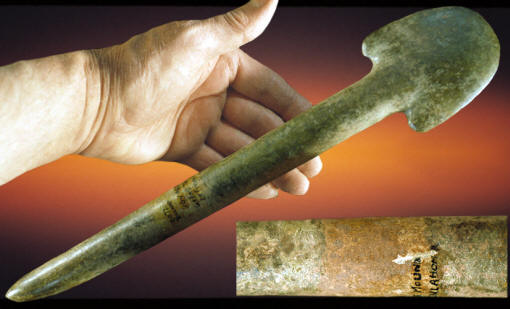
PRIVATE COLLECTION
SPUD
SPIRO MOUND SITE
LE FLORE CO., OKLAHOMA
MISSISSIPPIAN PERIOD, CADDOAN CULTURE
This spud or "ritual axe" was
photographed by Robert Bell. Brown identified this form of "ritual
axe" as a socio-technic ceremonial celt elongated form. He observed
that four ceremonial celts had hafting stains on the shank
indicating they were once hafted onto handles. This example also has
obvious hafting stains approximately one third of its length from
the end of the stem. This inset picture shows a close-up view of the
hafting stain. |
|
|
The cause of the greatest excitement of the Craig Mound excavation was
the discovery of the Great Mortuary tomb where a hollow cavity
preserved a large number of fragile items. Fantastic tales started to spread about an
elaborate central chamber filled with wonderful treasures. The
chamber was described as King Tut's tomb and a tapestried "Chiefs Room"
that contained an alter with a shrouded skeleton laying before it and an
urn filled with pearls. The central chamber did contain several types of
burials that ranged from simple bundles of bones to litter burials that
held people of high status. |
|
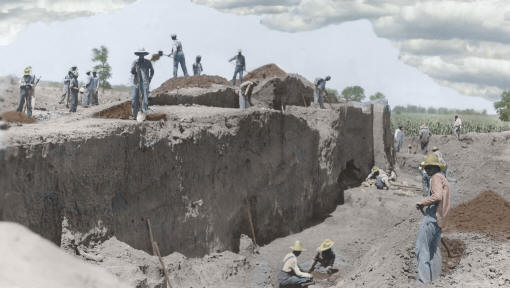
CLICK ON PICTURE FOR LARGER IMAGE
PHOTO FROM ROBERT BELL'S PHOTO ALBUM----LITHIC CASTING LAB
COLLECTION OF IMAGES.
COLORIZED BY PETE BOSTROM
WPA WORKERS EXCAVATING
THE LARGE MORTUARY MOUND
SPIRO MOUND SITE
LE FLORE CO., OKLAHOMA
MISSISSIPPIAN PERIOD, CADDOAN CULTURE
This picture was taken by Robert Bell in 1937. The original black
and white photograph has been colorized to highlight some of the
features. By this time the Pocola Mining Company excavators were
long gone and the WPA workers had taken over. The WPA excavated the
site for several years beginning in June, 1936 to 1941. There are 27
people in this picture doing several different activities. At top
left five men are standing around a water
jug. Just to the right, at the top of the mound, a man has just
thrown a shovel of dirt into the air. Nine or ten people in the
picture are at work with shovels. At least five people are on the
ground doing more detailed excavation. Remnants of the great
mortuary floor plan area can be seen near the small cavity along the
wall where three men are excavating caches of conch shells. |
|
|
Brown writes that, "The Spiro artifact record is primarily a corpus
of grave goods---. and "---the potential the Spiro artifacts have in
shedding light on a unique Mississippian Period site is excellent,
primarily because of the extensive array of burial inventories with
unparalleled diversity in grave goods." Most of the burials were
accompanied with varying numbers and quality of artifacts. One burial
contained, in addition to other artifacts, well over 100 conch shell
dippers. Another is reported to have contained an estimated 3,000 arrow
points. |
|
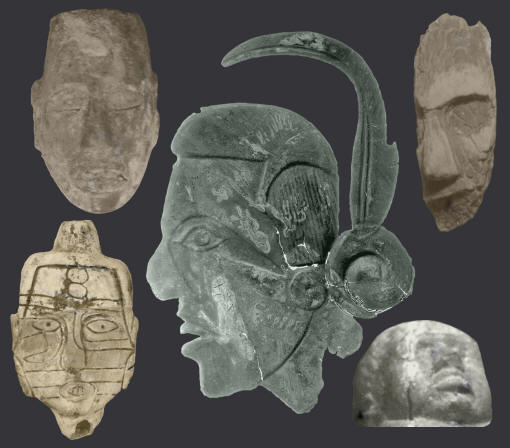
PHOTO FROM ROBERT BELL'S PHOTO ALBUM----LITHIC CASTING LAB
COLLECTION OF IMAGES.
COLORIZED BY PETE BOSTROM
HUMAN HEADS CARVED IN
WOOD, SHELL, COPPER & STONE
SPIRO MOUND SITE
LE FLORE CO., OKLAHOMA
MISSISSIPPIAN PERIOD, CADDOAN CULTURE
The excavation of Craig Mound
produced what has been described as one of the "richest' collections
of artifacts ever found in the United States. This picture
illustrates some of the examples of human effigies that Robert Bell
photographed during the excavations of the mound. The artifacts were
made from several different types of materials. The two human faces
at top right and left were carved in wood. The large central figure
with a feather curling over the head is made of copper. The human
face at lower left was carved from a piece of conch shell and the
image at lower right is from a figure carved in stone. |
|
|
Arrow points were the second most numerous artifact found in Craig
Mound. One cache of approximately 3,000 points is pictured in this
article. The cache was discovered in April 1935 by the Pocola Mining
Company excavators and sold to a secondhand furniture dealer from
Indianapolis, Indiana for $100. Brown describes at least 35 different
types of arrow points found during the WPA excavation of the mound. The
numbers of points they found in individual burial caches range from 10 points to 206
points. |
|
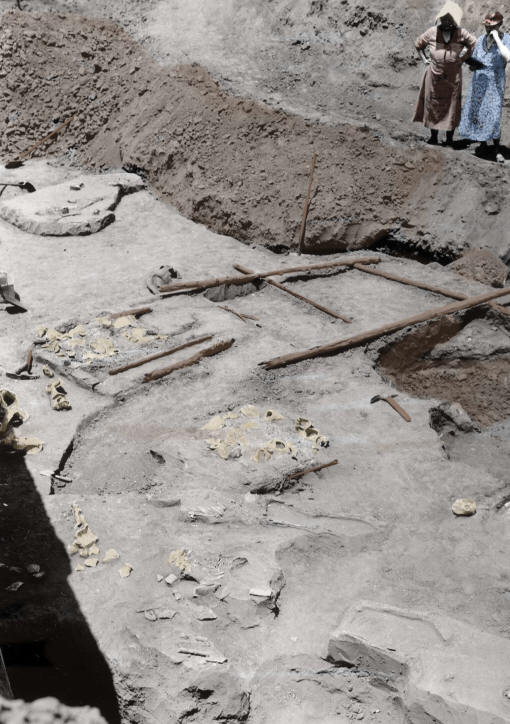
PHOTO FROM ROBERT BELL'S PHOTO ALBUM----LITHIC CASTING LAB
COLLECTION OF IMAGES.
COLORIZED BY PETE BOSTROM
CLICK ON PICTURE FOR LARGER IMAGE
CEDAR POLES & SHELL CACHES
ON THE FLOOR OF THE CENTRAL CHAMBER
SPIRO MOUND SITE
LE FLORE CO., OKLAHOMA
MISSISSIPPIAN PERIOD, CADDOAN CULTURE
This picture was taken in June of
1937 by Robert Bell. It shows two ladies looking down at the WPA
excavation of the "great mortuary" floor plan where the Pocola
Mining Company discovered an opening to the central chamber. Several
caches of conch shells can be seen along with some of the original
cedar poles that appear remarkably preserved. |
|
|
There were many spectacular artifacts found in Craig Mound. The most
colorful item found in the mound was a large biface. The color of the
stone is quite remarkable. A picture of it appears in this article.
It was discovered by Bill Heydon Vandagriff sometime in
April 1935. He found it while digging in one of the smaller mounds
located within the large saddle-shaped mound complex known as Craig
Mound. Robert Bell bought it in 1935 for his dad for $15.00. It
measures 13 1/8 inches long and 3/8 inch thick. Robert Bell
identified the material as Kay County chert from northern Oklahoma
but some believe it may be Kaolin chert from southern Illinois. |
|
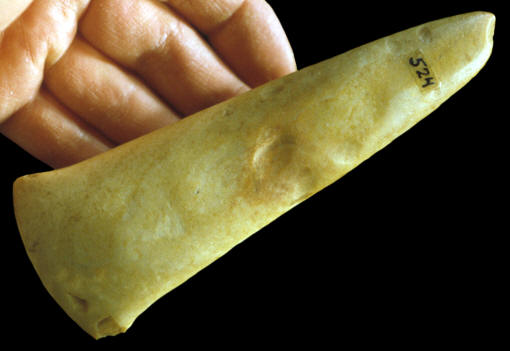
PRIVATE COLLECTION
SPUD
SPIRO MOUND SITE
LE FLORE CO., OKLAHOMA
MISSISSIPPIAN PERIOD, CADDOAN CULTURE
This Kaolin spud or "ritual axe" was
discovered by the Pocola Mining Company excavators in Craig Mound.
It was photographed by Robert Bell and was once in Harry T. Bell's
collection. Almost all of the flake scars have been removed by
polishing. There are one or more nicks on the blade edge which is
not uncommon on these types of polished spuds. |
|
|
One of the most important artifacts found during the excavation of Craig
Mound was a small obsidian scraper. It was discovered in 1935 by
artifact collector and dealer J. G. Bracklein in the east tunnel that was dug by the Pocola
Mining Company. Bracklein was known as, "a dedicated amateur
archaeologist who took great pride in his association with the
Smithsonian." He donated the scraper and other artifacts from Craig
Mound to the Smithsonian. The obsidian has since been identified as coming from a
source located at Pachuca, Hidalgo, Mexico. There has always been some
suspicion that direct contact with Mexico may have occurred with large
Mississippian period sites such as Spiro or
Cahokia. But little evidence in the form of physical artifacts has been
found so far. |
|
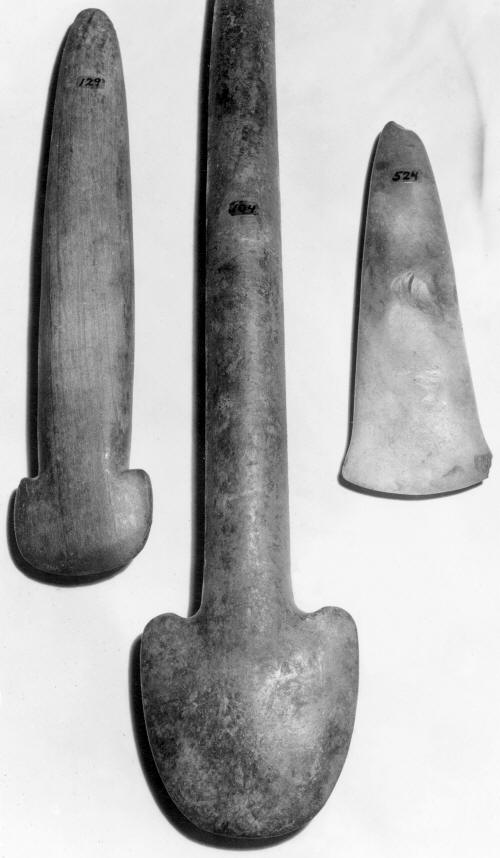
PHOTO FROM ROBERT BELL'S PHOTO ALBUM----LITHIC CASTING LAB
COLLECTION OF IMAGES.
SPUDS ("RITUAL
AXES")
SPIRO MOUND SITE
LE FLORE CO., OKLAHOMA
MISSISSIPPIAN PERIOD, CADDOAN CULTURE
This picture is from Robert Bell's
photo album. It shows two of the spuds illustrated in this article.
Many different types of spuds are reported to have been discovered
in Craig Mound. |
|
|
The most valuable artifacts found in Craig Mound are the engraved shell
items. Conch shell dippers were engraved with human figures, various
kinds of animals and geometric designs that depict mythological
creatures and scenes. These rarely preserved engravings actually
illustrate much of the culture's history. Like finding an ancient
library, unexpected and more than could have been hoped for. |
|

CLICK ON PICTURE FOR LARGER IMAGE
PHOTO FROM ROBERT BELL'S PHOTO ALBUM----LITHIC CASTING LAB
COLLECTION OF IMAGES.
LARGE CACHE OF ARROW POINTS
SPIRO MOUND SITE
LE FLORE CO., OKLAHOMA
MISSISSIPPIAN PERIOD, CADDOAN CULTURE
Large numbers of arrow points were
found in Craig Mound. This picture was taken by Robert Bell of an
incredibly large cache that is estimated to be around 3,000 arrow
points. This cache was discovered in April 1935 by the Pocola Mining
Company excavators and sold to a secondhand furniture dealer from
Indianapolis, Indiana for $100. Brown wrote that "Projectile points
are the second most numerous and diverse artifact category at
Spiro." Thirty-five different types of arrow points were found in Craig
Mound. The many caches found by the WPA salvage project ranged in
size from 10 points to 206 points. |
|
|
If Craig Mound hadn't been excavated in the 1930's
it would never have been excavated. Burial mounds are now protected by law and most
everyone would agree rightly so. But as with most complicated issues
there is a dilemma. Now that the digging of burial sites is a non issue,
the discussion of
it is unpleasant and awkward. But the dilemma is still fascinating all
the same and will never
go away. There is a good chance that other great mounds may also contain
ancient and fragile libraries. But, unlike the human spirit, the
physical objects will not last forever. |
|
"REFERENCES"
1936, Groves, G. I., "The Great
Temple Mound," The Indian Relic Collectors Guide, pp.22-28.
1935-1937, Robert Bells original photo album of black and white
photographs.
1952,
Hamilton, Henry W., "The Spiro Mound," The Missouri Archaeologist,
Vol. 14, October.
1975, Brown, James A. and Phillips, Phillip, "Pre-Columbian Shell
Engravings From The Crag Mound At Spiro, Oklahoma", pp. 1-7.
1976, Brown, James A., "Spiro
Studies, Volume 4," p. IV.
1980, Gardner, Joan S., "The Conservation Of Fragile Specimens From
The Spiro Mound, LeFlore County, Oklahoma," p. 1.
1981, Page, Barbara, "Spiro Mound Artifacts Reveal 12th Century
Culture,"
The Gilcrease Magazine Of American History And Art, p. 7- 8.
1996,
Fagan, Brian M., "The Oxford Companion To Archaeology", pp. 686.
2004, Merriam, Larry G., & Merriam, Christopher J., "The Spiro
Mound: A Photo Essay," p. 5.
|
|
RECENT
LISTINGS HOME
ORDERING |

